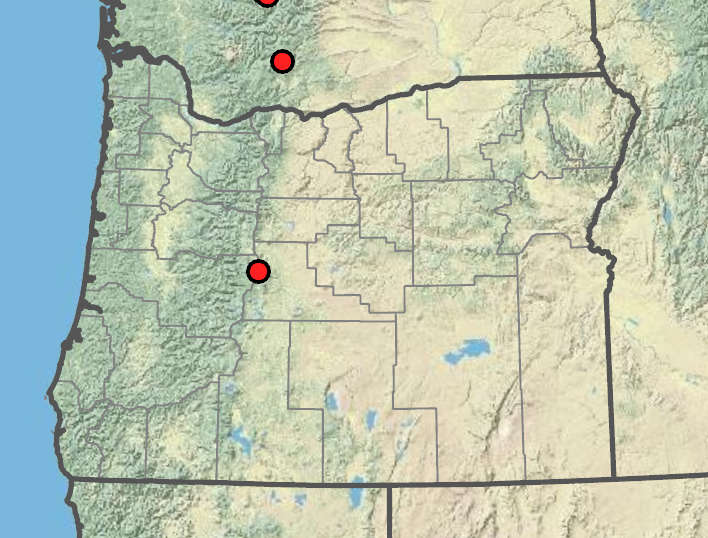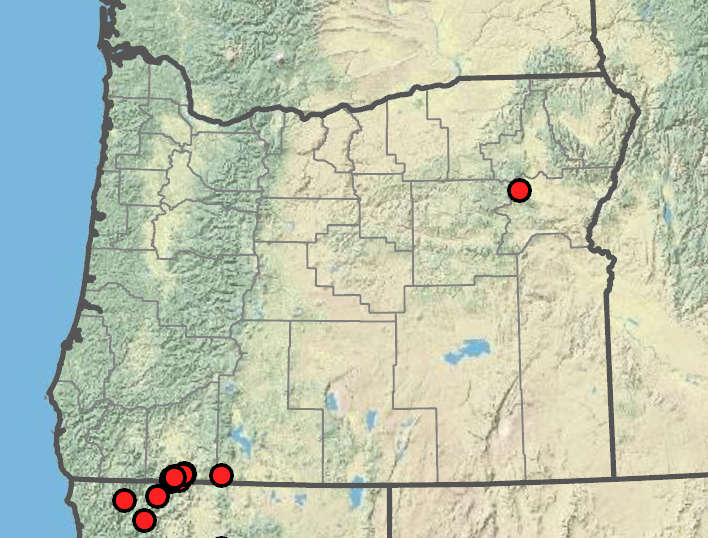Poa lettermanii
Poa pringlei
Letterman's bluegrass
Pringle's bluegrass
0.5–0.9 mm thick;
nodes 0(1) exserted.
intra- and extravaginal or mainly intravaginal.
intravaginal.
sheaths closed to 25% of their length;
ligules 1–3 mm;
blades flat or folded, or slightly inrolled, 0.5–2 mm wide.
sheaths terete, closed to 33% of their length, bases of basal sheaths glabrous, collar margins smooth or scabrous to hispidulous;
ligules (0.5)1–6 mm long, translucent;
tips truncate to acute, ligules of sterile shoots 1–2.5 mm long;
blades involute, frequently somewhat arcuate, 1.5–3 mm wide;
lower surfaces smooth;
upper surfaces densely scabrous or hispidulous;
cauline blades only slightly reduced higher on the culm.
erect, contracted, 1–3 cm long, usually exserted from the sheaths;
branches erect to steeply ascending; slender; to 1.5 cm.
erect, narrowly lanceoloid to ovoid, moderately congested, 1–6 cm;
spikelets 6–20(25);
branches erect, 0.5–1.5(2)cm, 1–2 per node, with 1–3 spikelets.
3–4 mm, green or purple;
florets 2–3;
rachilla internodes less than 1 mm long; smooth.
broadly lanceolate; to 3.5 times as long as wide, 6–8(12) mm; shiny;
florets 2–5;
rachilla internodes smooth.
lanceolate to broadly lanceolate, 2.4– 3.6(4) mm, usually equaling or exceeding the lowest lemma, frequently exceeding the upper florets;
lower glumes 3-veined.
lanceolate to broadly lanceolate, 3.5–7.5 mm, those of male plants shorter and with rounder tips than those of female plants; thin; shiny; almost transparent;
keels smooth or sparsely scabrous;
lower glumes slightly shorter than adjacent lemma, 3-veined.
glabrous.
glabrous.
lanceolate, 2.5–3 mm long, distinctly keeled; thin, glabrous;
keels and marginal veins rarely sparsely puberulent;
tips acute.
lanceolate, 5–8 mm, thinly membranous, distinctly keeled; smooth or sparsely finely scabrous, glabrous;
tips acute.
0.2–0.8 mm.
vestigial and 0.1–0.2 mm on female plants, 2–4 mm on male plants.
=14.
Poa lettermanii
Poa pringlei
Rocky alpine ridges and ledges. 2900–3100m. Casc. CA, ID, NV, WA; north to British Columbia, east to CO. Native.
This is a small, cespitose, alpine bluegrass, most similar to P. suksdorfii. Both have subequal glumes that tend to be longer than the lowest lemma, but P. suksdorfii has larger spikelets with longer glumes. In Oregon, P. lettermanii is known only from high elevation on South Sister in the central Cascades.
Rocky, subalpine and alpine slopes. 1200–2300m. Sisk. CA. Native.
Poa pringlei is a dioecious grass with relatively long, nearly transparent glumes. It is cespitose, but the culms spread horizontally at the base, making it appear rhizomatous.
Rob Soreng, Barbara Wilson, Richard Brainerd, Nick Otting
Rob Soreng, Barbara Wilson, Richard Brainerd, Nick Otting
- Local floras:
BC,
CA,
OR,
WA
- Local Web sites:
CalFlora,
CalPhotos,
Flora NW,
PNW Herbaria
WildflowerSearch
iNaturalist (observations)
USDA Plants Database
- LBJ Wildflower Center
- SEINet
- Plants of the World Online
- Encyclopedia of Life
- Wikipedia
- Google Image Search



